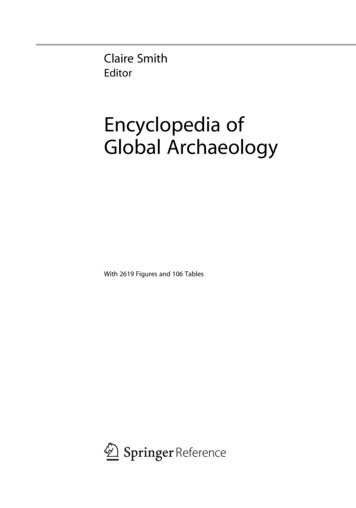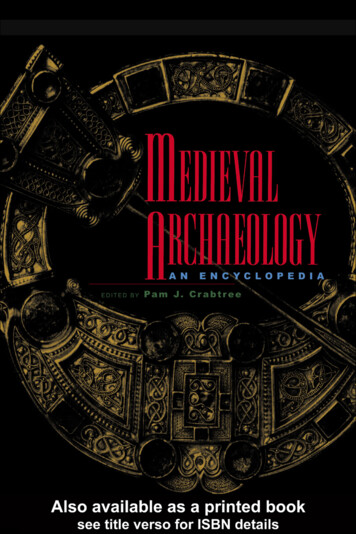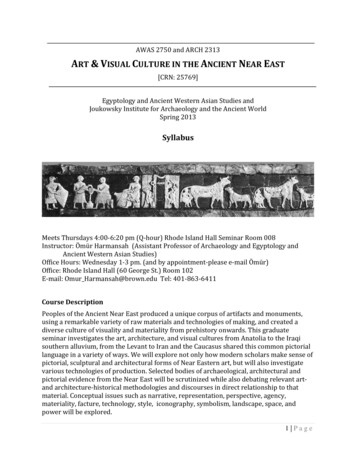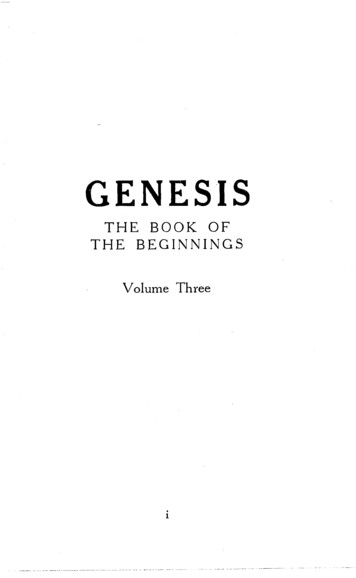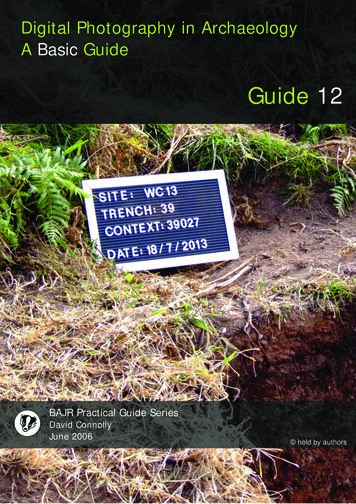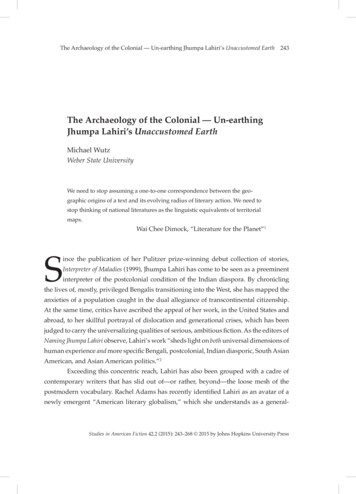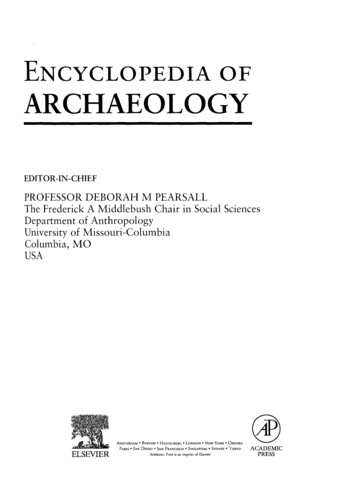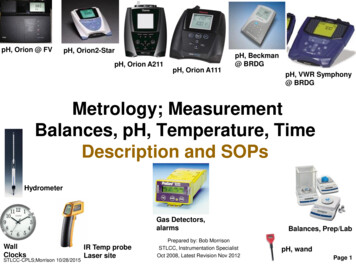
Transcription
History and Archaeology68ARCHAEOLOGICAL METROLOGY: ENGLISH, FRENCH, AMERICANAND CANADIAN SYSTEMS OF WEIGHTS AND MEASURES FORNORTH AMERICAN HISTORICAL ARCHAEOLOGYLester A. RossNational Historic Parks and Sites BranchParks CanadaEnvironment Canada1983
Minister of Supply and Services Canada 1983.Available in Canada through authorized bookstore agents and otherbookstores, or by mail from the Canadian Government Publishing Centre,Supply and Services Canada, Hull, Quebec, Canada K1A OS9.En fran ais ce numero s'intitu1e Histoire et archeo1ogie nO 68(nO de catalogue R64-81/1983-68F). En vente au Canada parl'entremise de nos agents 1ibraires agrees et autres 1ibrairies, ou par1a poste au Centre d'edition du gouvernement du Canada,Approvisionnements et Services Canada, Hull, Quebec, Canada K1A OS9.Price Canada: 7.75Price other countries: 9.30Price subject to change without notice.Catalogue No.: R64-81/1983-68EISBN: 0-660-11336-8ISSN: 0225-0101Published under the authorityof the Minister of the Environment,Ottawa, 1983.A list of publications is available from Research Publications,Parks Canada, 1600 Liverpool Court, Ottawa, Ontario, K1A 1G2.Editor:Paula Irving.The opinions expressed in this report are those of the authorand not necessarily those of Environment Canada.
3ARCHAEOLOGICAL METROLOGY: ENGLISH, FRENCH, AMERICAN AND CANADIANSYSTEMS OF WEIGHTS AND MEASURES FOR NORTH AMERICAN HISTORICAL ARCHAEOLOGYLester A. RossE91]16Ab s t r ac tAcknowledgementsIntroductionEnglish Systems of Weights and Measures16Dry Weight Systems20Tower Pound Weight System (791 - 1527)21Merchants' Pound Weight System (in Britain, 1266 - 1527)21Hanseatic Herchants' Pound Height System (in Britain,pre-13th century - 1582)22Avoir-du-pois Pound \veight System (1340 - 1582)22Avoir-du-pois Wool Weight System (1352 - 1582)23Avoir-du-pois Hay Weight System (1352 - 1582)23Avoir-du-pois Coal Weight System (1352 - 1582)24Haverdepoise Herchants' Pound Weight System (1497- 15(2)24Henry VII Winchester Corn Weight System (1497 - 1601)25Troy Pound Weight System (1497 - present)25Troy Corn 'iveight System (post-1497 - 7 )Troy Imaginary Mint Weight System (post-1497 ·-7 )26Troy Imaginary Mint Height System (post-1497 - 7 )26Troy Pound Carat Weight System (post-1497 - 7 )27Ounce Carat Weight System (post-1497- 7 )2728Jewellers' Weight System (post-1497 - 7 )28Apothecary Weight System (post-1497 - 20th century)29Avoirdupois Pound Weight System (1582 - present)29Avoirdupois Wool Weight System (post-1582 - 7 )30Avoirdupois New Hay Height System (post-1582 - 7 )30Avoirdupois Old Hay Weight System (post-1582 - 7 )31Avoirdupois Straw 'iJeight System (post-1582 - 7 )31Avoirdupois Coal Weight System (post-1582 - 7)32Avoirdupois Salt Weight System (post-1582 - 7 )32Avoirdupois Lead Weight System (post-1582 - 7 )33Avoirdupois Stannary Height System (post-1582 - 7 )33Avoirdupois Gunpowder Height System (post-1582 - 7 )34Avoirdupois Glass Weight System (post-1582 - 7 )Elizabeth I Winchester Corn Weight System (1601 - 1702)3435William III Winchester Corn Weight System (1702 - 1826)35Liquid Weight Systems36Winchester Wine Apothecary Liquid Weight System (pre-1707 1826)36Imperial Apothecary Liquid Weight System (1826 - 7 )Dry Capacity Systems3738Henry VII Winchester Corn Capacity System (1497 - 1601)38Elizabeth I Winchester Corn Capacity System (1601 - 1702)
394041William III Winchester Corn Capacity System (1702 - 1826)Imperial Dry Capacity System (1826 - present)Imperial Coal Capacity System (1826 - present)42Liquid Capacity Systems43Henry III Merchants' Wine Gallon System (1266 - 1707)44Henry VIr Winchester Wine and Ale Gallon System (1497 1601)44Elizabeth I Wine and Ale Gallon System (1601 - 1826)45Queen Anne Winchester Wine Gallon System (pre-1707 - 1826)46Ale Gallon System ( ? - 1803)47Beer Gallon System ( ? - 1826)48Ale and Beer Gallon System (1688 - 1803)49Imperial Liquid Capacity System (1826 - present)50Imperial Culinary Liquid Capacity System (1826 - present)50Linear Systems51English or Primary Standard Linear System (1305 - 1826)52English Cloth Measures (dates unknown)52English Wool Cordage Measures (dates unknown)53English Cotton Cordage Measures (dates unknown)53English Linen Cordage Measures (dates unknown)54Imperial Linear System (1826 - 20th century)54Superficial System55English Area System (1305 - present)56Volumetric System56English Volume System (1305 - present)57French Systems of Weights and Measures58Dry Weight Systems59Systeme de poids de Marc de Troyes (1350 - 1840)60Systeme de poids d'Easterlin (1350 - 1840)60Systeme de poids pharmaceutique (? - post-1791)61Pr ern Le r sys t eme metrique de poids pharmac eut Lque(post-1791 - 1840)62Systeme metrique de poids (1840 - present)63Systeme metrique de poids pharmaceutique (1840 - ?)64Liquid We Lg ht; Systems64Dry Capacity Systems65Systeme de capacite pour les matieres seehes de Bordeaux(? - 1840)65Systeme de capacite pour les matieres seches de la Rochelle(? - 1840)66Systeme de capacite pour les matieres seches de la Rochelleemploye pour Ie sel (? - 1840)66Systeme de capacite pour les matieres seehes de Lyonemploye pour les grains (? - 1840)67Systeme de capacite pour les matieres seehes de Marseilleemploye pour Ie ble (? - 1840)67Systeme de capacite pour les matieres seches de Parisemploye pour les grains et la chaux (? - 1840)68Systeme de capacite pour les matieres seehes de Parisemploye pour l'avoine (? - 1840)68Systeme de capaeite pour les matieres seehes de Parisemploye pour Ie charbon (? - 1840)
56972758185Systeme de capacite pour les matieres seches de Parisemploye pour Ie charbon de bois (? - 1840)69Systeme de capacite pour les matieres seches de Parisemploye pour Ie sel (? - 1840)70Systeme de capacite pour les matieres seches de Rouenemploye pour Ie ble (? - 1840)70Sys t eme de capac Lt e pour les ma t Ler es sec he s de Rauenemploye pour le charbon (? - 1840)71Systeme de capacite du Boisseau usuel pour les matieresseches (1812 - 1840)71Systeme metrique de capacite pour les matieres seches etles liquides (1840 - present)Liquid Capacity Systems72Systeme de capacite pour les liquides de Bordeaux(? - 1840)72Systeme de capacite pour les liquides de Lyon (? - 1840)73Systeme de capacite pour Ie vin de Marseille et de Toulon(? - 1840)73Systeme de capacite pour l'huile de Marseille et de Toulon(? - 1840)74Systeme de capacite pour les liquides de Paris (? - 1840)74Sy s t eme de capac I t e pour les liquides de Rouen (? - 1840)74Systeme metrique de capacite pour les liquidesLinear Systems76Ancien systeme de longueur du pied du roi (ca. 8th century 1668)77Systeme de longueur du pied du roi (1668 - 1840)78Mesures des cordages en laine (1668 - 1840)78Mesures des cordages en lin (? - 1840)79Systeme de longueur du pied de St-Hubert de Liege(? - 1840)79Systeme de longueur du pied de St-Lambert de Liege(? - 1840)80Systeme metrique de longueur au du pied usuel (1812 - 1840)80Systeme metrique de longueur (1840 - present)Superficial Systems82Ancien systeme de surface du pied du roi (ca. 8th century 1668)82Systeme de surface du pied du roi (1668 - 1840)83Systeme de surface du pied de St-Lambert de Liege(? - 1840)83Systeme de surface de Liege pour 1e bois (? - 1840)84Systeme de surface du pied usuel (1812 - 1840)84Systeme metrique de surface (1840 - present)Volumetric Systems85Ancien s ys t eme des volumes du pied du roi (ca. 8th century 1668)85Systeme des volumes du pied du roi (1668 - 1840)86Systeme metrique des volumes au systeme des volumes du piedusuel (1812 - 1840)86Systeme metrique des volumes (1840 - present)
687American Systems of Weights and MeasuresDry Weight Systems87American Troy Pound Weight System (1497 - present)87American Apothecary Weight System (post-1497 - 20thcentury)88American Avoirdupois Pound Weight System (1582 - present)88Liquid Weight Systems89Dry Capacity System89American Dry Capacity System (1702 - present)89Liquid Capacity System89American Liquid Capacity System (1707 - present)90Linear System90American Linear System (1305 - present)90Superficial System90American Area System (1305 - present)90Volumetric System90American Volume System (1305 - present)Canadian Systems of Weights and Measures92Dry Weight Systems92British Columbia, Including the Colonies of VancouverIsland and British Columbia (1858 - 1871)92New Brunswick (1784 - 1867)92Newfoundland (1832 - 1900)93Nova Scotia (1758 - 1867)93Prince Edward Island or the Island of St. John (1773 1873)93Quebec or Lower Canada (1663 - 1867)93Upper Canada (1791 - 1867)94Province of Canada, Including Upper and Lower Canada (1848 1867)94Dominion of Canada (1867 - 1900)95Liquid Weight Systems95Dry Capacity Systems95British Columbia, Including the Colonies of VancouverIsland and British Columbia (1858 - 1871)95New Brunswick (1784 - 1867)96Newfoundland (1832 - 1900)96Nova Scotia (1758 - 1867)96Prince Edward Island or the Island of St. John (1773 1873)96Quebec or Lower Canada (1663 - 1867)97Upper Canada (1791 - 1867)97Province of Canada, Including Upper and Lower Canada (1848 1867)97Dominion of Canada (1867 - 1900)98Liquid Capacity Systems98British Columbia, Including the Colonies of VancouverIsland and British Columbia (1858 - 1871)98New Brunswick (1784 - 1867)98Newfoundland (1832 - 1900)98Nova Scotia (1758 - 1967)98Prince Edward Island or the Island of St. John (1773 1873)8791
7989898Quebec or Lower Canada (1663 - 1867)Upper Canada (1791 - 1867)Province of Canada, Including Upper and Lower Canada (1848 1867)98Dominion of Canada (1867 - 1900)99Linear Systems99British Columbia, Including the Colonies of VancouverIsland and British Columbia (1858 - 1871)New Brunswick (1784 - 1867)9999Newfoundland (1832 - 1900)99Nova Scotia (1758 - 1867)99Prince Edward Island or the Island of St. John (1773 1873)99Quebec or Lower Canada (1663 - 1867)99Upper Canada (1791 - 1867)100Province of Canada, Including Upper and Lower Canada (1848 1867)100Dominion of Canada (1867 - 1900)Superficial Systems100British Columbia, Including the Colonies of Vancouver100Island and British Columbia (1858 - 1871)100New Brunswick (1784 - 1867)100Newfoundland (1832 - 1900)100Nova Scotia (1758 - 1867)100Prince Edward Island or the Island of St. John (1773 1873)101Quebec or Lower Canada (1663 - 1867)101Upper Canada (1791 - 1867)Province of Canada, Including Upper and Lower Canada (1848 1011867)101Dominion of Canada (1867 - 1900)101Volumetric Systems102 Appendix A. Acts and ordinances regulating weights and measuresused within Canada and its provinces during the 17ththrough 19th centuries121 References Cited
8ABSTRACTTo facilitate recognition of cultural units of measure associatedwith Euroamerican archaeological remains in North America, knowledge ofhistoric measurement systems commonly used by Euroamericans isessential. For Canadian research, specific systems used in England,France, America and Canada during the 15th - 19th centuries provide acomprehensive view of the plethora of measurement units in common use.Measurement units constituting these systems are systematicallyorganized by country, type of measurement system and period of usage.To facilitate commercial research of archaeological remains inCanada, a compilation of the major legislative statutes governing theuse of weights and measures provides a glimpse of measurement customsand regulations which governed commerce during the 17th - 19thcenturies.To facilitate future research within archaeological metrology, sixinferences of metrological systems, units and archaeological remains areinferred from observations of historic measurement systems, suggesting afew of the more relevant correspondences among systems, units andsurviving remains.Submitted for publication 1980, by Lester A. Ross, Parks Canada, Ottawa.
9ACKNOWLEDGEMENTSIn conducting research for this work, extensive use was made ofspecial reference collections at the Yale Medical Library and theNational Library of Canada. I express my sincere appreciation toFerenc Gyorgyey and his staff at the Yale Medical Library, and to JohnStreeter, who provided assistance and guidance in the use of the EdwardClark Streeter reference library on historic weights and measures. Myappreciation is also extended to archivists Betty Deavy and Bill Murphyof the National Library of Canada, and to librarian Michael Graham ofthe Library of Parliament, for their cooperation and assistance inlocating copies of the numerous laws and statutes pertaining to theadoption of weights and measures within Canada and its provinces.
11INTRODUCTIONJack and Jill went up the hillTo fetch a pail of water.Jack fell down and broke his crown,And JilZ came tumbling after.(Klein 1974:39)The Greeks had a word for it - met ologia - denoting the theory ofratios. In our present age, metrology denotes the study of systems ofweights and measures. For many non-literate societies, weights andmeasures appear to be idiosyncratic or communal, while amongcommercially oriented and literate societies, weights and measures tendto be societal, regional and national. Literate societies also attemptto standardize and codify metrological systems for the explicit goal ofregulating trade. For such societies, research on past systems tends tobe historical, but as one well-known classical archaeologist came torecognize, many historical metrological systems were either neverhistorically recorded or their records of existence have subsequentlybeen lost.At the 9 April 1878 meeting of the Anthropological Institute ofGreat Britain, William Flinders-Petrie read a paper on inductivemetrology in which he defined his subject as the deduction of ancientunits of measure from measurements of existing archaeological remainsof both historic and prehistoric architectural features (Nature 1878).One year earlier, Flinders-Petrie (1877) published his initial work oninductive metrology and through his lifelong work on pharaonic Egyptianarchaeology he consistently demonstrated the value of historical andarchaeological metrology for the description and interpretation ofarchitectural and commercial remains (e.g. Flinders-Petrie 1926, 1931).Flinders-Petrie noted that cultural units of measure were easilydiscernible from surviving architectural remains, and argued that suchunits should be explicitly sought with the goal of defining ancientsystems of linear measure.Extending Flinders-Petrie's primary goal, archaeologists shouldseek to define culturally significant metrological units and systems forall categories of material culture, not just architectural structures.Within the anthropological and archaeological disciplines, one commonlyheld belief is that mankind produces material culture according topreconceived mental templates. As such, items are manufactured to meetpre-existing material, functional, stylistic and metrologicalrequirements. Thus, the manufacture of a lithic projectile point by apre-literate knapper may be subjected only to material, functional andstylistic requirements, while the manufacture of a firearm cartridgemust also meet rigorous requirements of size and mass.Archaeological research of material culture generally requires sizedetermination, occasionally for interpretive purposes, but more oftenonly for descriptive purposes. Archaeologists have a penchant fordiscovering statistically meaningful sizes, but rarely are such research
12sizes related to cultural units and systems. In measuring artifacts,archaeologists attempt to discover valid sizes which have somesignificance for interpretive conclusions. Complete measurements aretaken in order to define absolute size variability and relative sizecomparisons which may be useful for research purposes (Figure 1). Oncean absolute size, with its variability, has been defined, partialartifact measurements can also serve to help identify research sizes.Normally, researchers generate size information for the purpose ofdemonstrating stylistic variability within an artifact class.Occasionally, however, sizes are compared to cultural measurement unitsin an attempt to document an historical interpretation; but rarely areattempts made to document or reconstruct cultural measurement systems.Cultural measurement systems consist of two basic classes ofsystems - relative and metrological (or absolute) systems (e.g. Figure2). Relative systems attempt to size material according to a hierarchyof relative units which are vaguely defined in relation to one another.For example, British clothing merchants used the unit vest button tosignify the size of a button larger than a shipt button but smallerthan a bpace button (Figure 2). The actual metric size of a vestbutton probably had a wide range of variability, and may haveoverlapped in size with both shipt and bpace buttons.Metrological systems, however, attempt to size material according to amathematical scale of multiple units which are more or less preciselydefined according to a standard unit of measure and which generallyshare one or more common ratios of relationship to one another. Forexample, American clothing merchants used the metrological unit of aline (0.635 mm) to measure button sizes, with sizes ranging between8-50 lines. In this instance of a metrological system, only onemetrological unit was required, and sizes were designated by amathematical ratio of even-numbered lines.For these two basic classes of cultural measurement systems thereare seven types of systems classified within three groups defined by thestandards used to define each system (Table 1).Table 1.Types of cultural measurement systems classified accordingto standards used to define each system.System StandardsTypes of Measurement SystemsMass StandardsDry Weight SystemsLiquid Weight SystemsCapacity StandardsDry Capacity SystemsLiquid Capacity SystemsLinear StandardsLinear SystemsSuperficial SystemsVolumetric Systems
NTOBJECTMEASURDffiNT-----F ;cLl-- ISTICALRELATIVERESEARCHSIZES--- I -----------l'- ---: r']J - �SYSTEMSYSTEMFigure 1. Relationships among material culture measurements,postulated sizes, cultural units and systems of weights andmeasures for archaeological research.a)British Clothing Button SizesShirtVestBraceJacketCoatOvercoatb)American Clothing Button Sizes (8-50 lines)8 10 12 ,. III If 20222't26283032Jt36to50Figure 2. Examples of relative vs. metrological cultural systems forsizing 19th-century clothing buttons: a) relative cultural system usedby British merchants (Ross 1976: 1380) and b) metrological culturalsystem, based upon a culturally unidentified line measuring 0.57 mm,used by American merchants (Montgomery Ward & Co. 1895: 85).
14Standards applied to systems within a single group representprimary standards while standards associated with systems from one groupand applied to systems within another group represent secondarystandards. Thus, a capacity standard used to define dry or liquidcapacity systems is a primary standard, but when used to define a dryweight system it becomes a secondary standard. For example, thebushel used to define wheat capacity in England during the 15thcentury would be regarded as a primary standard for the Henry VIIWinchester Corn Capacity System, but when it was used to define wheatweight as in the Henry VII Winchester Corn Weight System it functionedas a secondary standard. According to the definition of wheat weightused by Henry VII, a bushel of wheat weighed 66 2/3 Troy pounds.For the dry weight system, the Troy pound was the primary standard,while the weight of a bushel of wheat from the dry capacity systemwas the secondary standard.Reliance upon mass, capacity and linear standards for various typesof measurement systems is paramount and must be both explicitlyunderstood and well defined in order to reconstruct historic culturalsystems from existing artifact measurements. When research measurementsare taken according to a linear standard, they must be converted to acapacity standard in order to reconstruct a capacity system. Likewise,standards used to measure artifacts must be well known and convenient towork with so that discrete cultural units and ratios of such units canbe easily recognized by the researcher. To facilitate the collection,manipulation and interpretation of metrological data the basic standardsto be employed in research are metric weight, capacity and linear units.Converting from these units to other cultural units has becomerecognized as the accepted method for all metrological research, and thetables forming the body of the following report have been established tofacilitate such conversions.Prior to initiating the reconstruction of historical units andsystems of measurement, it is desirable to have access to all availablehistoric systems pertaining to the culture in question. For NorthAmerican historical archaeologists working with European materialculture, it would be desirable to have access to a resource documentlisting all European and North American measurement systems used duringthe 15th through 20th centuries. Such a document is non-existent, butin an attempt to partially remedy this problem, information has beencompiled for many of the more common English, French, American andCanadian systems in use during the 15th through 19th centuries. Thesesystems have been identified from various published sources, and havebeen arranged by country, type of measurement system and period of use.This collection of systems is far from complete, but it should serve asa basic guide to the major systems represented in North America.Through subsequent research it is hoped that specific systems used forvarious classes of material culture may be explicitly identified, suchas the button systems mentioned previously, and such as the systems usedfor glass beads, nails, ceramics and glass vessels, etc. Through suchresearch, the goal is to demonstrate the significance of metric data forderiving cultural and temporal ascriptions, and for identifying anddescribing unrecognized historic systems of measurement. Perhaps withthe publication of the following collected work of known historical
15systems of measurement, other researchers will be encouraged to analyzetheir metric data with similar goals in mind - such at least is the hope.
16ENGLISH SYSTEMS OF WEIGHTS AND MEASURESUnlike the French systems of weights and measures, English systemswere primarily based upon national systems enacted in law by the Crown.There were also city and county systems, but their usage was officiallydiscouraged by the use of regional inspectors who possessed "exact"copies of royal metrological standards. Through use, these comparativestandards often became inaccurrate copies of original standards whichonly approximated the true metrological units of their systems.However, the use of these regional inspectors and gaugers did helpalleviate regional variability for national and international commerce,and this national uniformity should be reflected by English materialcul, t ure Dry Weight SystemsOf the 29 English dry weight systems identified (Table 2), sevencan be regarded as systems of major importance (Figure 3); threepresumed systems, based upon secondary dry capacity standards andprobably used in the weighing of wheat, were of insignificant importancefor the weighing of other commercial commodities; and the remaining 19systems were based upon the seven major systems.The two primary standards for the seven major systems were thewheat and T oy g ains of 0.04556 g and 0.0648 g, respectively.These standards were physically embodied within each dry weight systemby a larger unit known as a pound, with each pound beingidentified by the total number of wheat and/or T oy g ains itcontained. Unfortunately, few pound standards survived into morerecent times, thus denying modern scholars an opportunity to check theaccuracy of earlier systems. In fact, the question of weightvariability for wheat and T oy g ains through time has neverbeen completely addressed, and it is highly likely that physicalpound standards maintained by the Crown and various merchant guildsvaried considerably in relationship to their mathematical counterparts.From this observation it is inferred that metrological systems identifymathematical relationships among metrological units, but the physicalunits of a system will not always equate in size or mass with theircorresponding metrological units.Thus, metric weights given in the following tables must be regardedas approximate weights which undoubtedly varied within the realmarketplace. For comparative historical archaeological purposes,recognition of the relative weight ratios among the seven major systemsis essential. The Towe pound was the lightest of all, with theHaverdepoise pound being the heaviest (Table 3).
17Table 2.English dry weight systems and their known period of usage(*presumed system).ENGLISH DRY WEIGHT SYSTEMSTower PoundMerchants' PoundHanseatic Merchants' PoundAvoir-du-pois PoundPERIOD IN USE791 - 15271266 - 1527pre-13th C - 15821340 - 1582Avoir-d u-pois WoolAvoir-du-pois HayAvoir-du-pois CoalHaverdepoise Merchants' Pound1497 - 1582Henry VII Winchester Corn*1497 - 1601Troy Pound1497 - 20th CTroy CornTroy Imaginary MintTroy Pound CaratTroy Ounce CaratJewellers'ApothecaryAvoirdupois Pound1582 - 20th CAvo irdupois WoolAvoirdupois New HayAvoirdupois Old HayAvoirdupois StrawAvoirdupois CoalAvoirdupois SaltAvoirdupois LeadAvoirdupois StannaryAvoirdupois GunpowderAvoirdupois GlassElizabeth I Winchester Corn*1601 - 1702William III Winchester Corn*1702 - 1826
18PERIOD IN USEENGLISH DRY WEIGHT SYSTEMS140015001600170018001900IJJIIITower PoundMerchants' PoundHanseatic Merchants' PoundAvoir-du-pois PoundHaverdepoise PoundTroy PoundAvoirdupois PoundFigure 3.Comparison of the major English dry weight systemsand their period of usage (post-1400).
19Table 3.Comparison of weights among the seven major English dry weightpounds in use during the 15th through 19th centuries.ENGLISH DRY WEIGHT POUNDSTROY POUNDSGRAMSTower Pound5400349.92Troy Pound5760373.248Merchants' Pound6750437.40Avoir-du-pois Pound6992453.0816Avoirdupois Pound7000453.60Hanseatic Merchants' PoundHaveY'depoise Pound7200466.567680497.664Utilizing these relative weight relationships among the seven majorsystems, artifacts can be weighed and compared to expected weights inorder to postulate original cultural metrological units. For example,if an axe head found within a 19th-century context weighed 1810 g, itcould be postulated that on the basis of its weight alone, the axe headwas manufactured in a country using the Avoirdupois Pound Weight System,since its weight corresponds to four Avoirdupois pounds. ForCanadian historical archaeological sites, this comparative approachcould be used to distinguish material culture manufactured by Englishv s . French tradesmen. Similar examples of weight variations formaterial culture could also assist in the ascription of the temporalperiod of manufacture and in the identification of specific dry weightsystems used in the manufacture of specific classes of commodities.From these observations, it is inferred that object measurements used toidentify metrological units and systems can also be utilized to ascribeboth cultural and temporal affiliations.
20TOWER POUND WEIGHT SYSTEM (791 - 1527)The Moneyer's or Saxon pound (791 - 1066) or Moneyer'sTower pound (1066 - 1527) was defined by Offa, Anglo-Saxon King ofMercia (757 - 796) in 791 on the basis of the Arabic silver halfdirhem of 22-23 grains and officially abolished in 1527 by HenryVIII. The Tower pound was incorrectly identified as a Troypound on a 1746 broadside purportedly taken from the Table of StandardWeights and Measures of the Exchequer for 1497 (Standard . 1746). Thistable was prepared from weights given in Skinner 1967 and Zupko 1977: 11and 78. NOTE: The modern grain of amber durum wheat weighs between0.0421-0.0439 g (Canadian Grain Commission 1978).METRIC0.04556 g1Wheat Grain0.0648g1.422 . 11. 822.3949 kgTroy GrainPennyweightTower OunceTower PowtdTower CaUan1Tower Bushe L
21MERCHANTS' POUND WEIGHT SYSTEM (in Britain, 1266 - 1527)The Merchants' pound was in use among southern German citiesand was officially enacted in Britain in 1266 by Henry III and abolishedin 1527 by Henry VIII. This table was prepared from weights given inSkinner 1967 and Zupko 1977.METRICWheat Grain0.04556 g10.0648g1. 422 Merchants' ,20096064827.9936 kgTroy GrainPennyweightTower OunceGallon1Bushe tHANSEATIC MERCHANTS' POUND WEIGHT SYSTEM (in Britain, pre-13thcentury - 1582)The Hanseatic Merchants' pound was in use among northern Germanand Baltic coastal cities prior to its use by the Hanseatic merchants ofLondon during the 13th century. It was officially replaced in 1582 byElizabeth I. This table was prepared from weights given in Moody 1960,Skinner 1967 and Zupko 1977.METRICWheat Grain0.04556 g10.0648g1.422 .11. 2464829.8598 kgTroy GrainPennyweightTower OunceHanseatic Merchants' PoundGallon1Bushel
22AVOIR-DU-POIS POUND WEIGHT SYSTEM (1340 - 1582)The Avoip-du-pois pound of Edward III was established in 1340and was replaced in 1582 by Elizabeth I. This table was prepared fromweights given in Skinner 1967 and Zupko 1977.METRICWheat Groin0.04556g10.0648g1.422 .128.3176g621. 54371113.2704 g2486174841226.5408 g49723496821453.0816 g994469921642Troy GrainAvoir-du-pois OunceQuarter PoundHalf Pound1Avoir-du-pois PoundAVOIR-DU-POIS WOOL WEIGHT SYSTEM (1352 - 1582)This system was based upon the Avoip-du-pois pound establishedin 1352 and replaced in 1582, and was used in the national commerce ofwool. This table was prepared from weights given in Skin
ARCHAEOLOGICAL METROLOGY: ENGLISH, FRENCH, AMERICAN AND CANADIAN SYSTEMS OF WEIGHTS AND MEASURES FOR NORTH AMERICAN HISTORICAL ARCHAEOLOGY Lester A. Ross E Abs t ract 9 Acknowledgements 1] Introduction 16 English Systems of Weights and Meas
